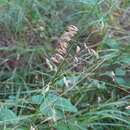en
names in breadcrumbs


Melica nitens is a species of grass known by the common names threeflower melicgrass or three-flowered melic.[3] It is native to the central United States.[4][1]
This perennial grass has short rhizomes and sometimes forms bunches. The stems grow up to 1.3 meters tall. The inflorescence is a branching panicle of spikelets. The spikelets normally have three perfect flowers in one sided panicles.[3] Despite its name, the grass may also have spikelets with two or four flowers each,[4] often two.[5] The rachilla is longer than the fertile florets, and terminates in a club.[3] The sterile florets are two empty lemmas.[3]
In the wild this plant grows in wooded areas, grasslands, streambanks, and roadsides.[5] In some areas it is considered "highly threatened by land-use conversion and habitat fragmentation, and to a lesser extent by forest management practices."[1] In other areas it is cultivated and sown as a forage grass.[5] In the US state of Minnesota, where it reaches its most northerly range in the extreme south eastern part of the state, it is listed as a threatened species; it was historically found in sandy soiled woodlands and prairie.[3] In Wisconsin it is listed as a Special Concern plant, and is found on steep slopes or rocky embankments around the states southern floodplains, mesic forests, and dry prairies.[6]
Melica nitens is a species of grass known by the common names threeflower melicgrass or three-flowered melic. It is native to the central United States.